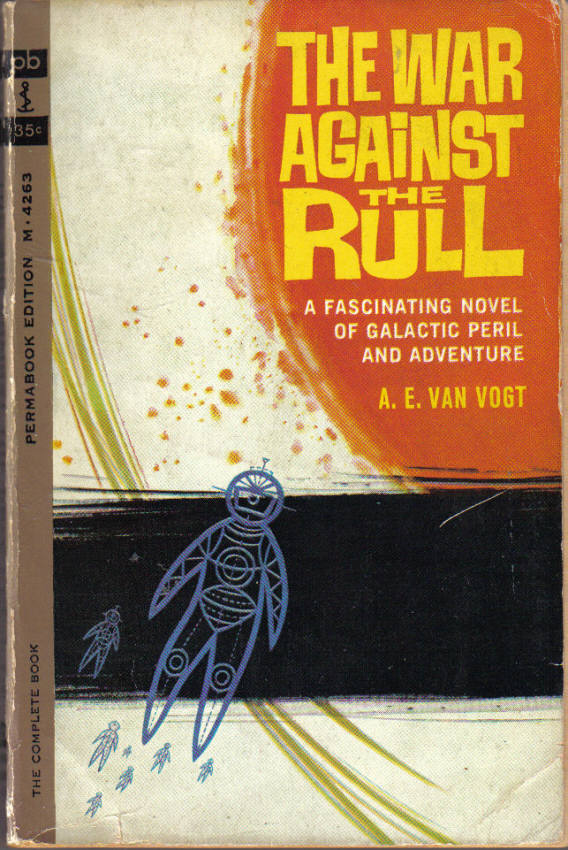 It should be pretty obvious why I bought The War Against the Rull by A. E. Van Vogt (1959). Look at the tiny spacemen on the cover! And they are on the title page too! I love those little guys.
It should be pretty obvious why I bought The War Against the Rull by A. E. Van Vogt (1959). Look at the tiny spacemen on the cover! And they are on the title page too! I love those little guys.The book, I liked alright. It was more of a space battles and alien monsters kind of science fiction book than I really like. The book was put together from several of Van Vogt's short stories, along with some new material, and you can tell -- the choppy character of the plot isn't smoothed together all that well.
The book follows our hero Trevor Jamieson as he travels from planet to planet, working to strengthen the alliances between humans and other life forms in the galaxy (basically by dominating their planets and forcing them to join the coalition and let Earthlings build military bases on their planets). The primary reason for the alliance is to stop the Rull from taking over planets in our galaxy. The Rull are from someplace way far away, no one can understand them or their technology, and in their regular form they look kind of like giant black worms. Most of the time, however, these shape-shifters take the form of your friend, colleague, or acquaintance and infiltrate Earth society that way. Tricky. Makes you ask: Is that a Rull sitting next to you?
The Rulls are actually pretty neat, but although they are mentioned quite a bit throughout the book, they don't really show up as a major part of the plot until the book is over halfway through. I could have used a little more Rull in a book with Rull in the title...
Finally, I have to let the women's studies major in me out for a minute and address the treatment of female characters in this book. Actually, beyond the occasional secretary, there are only two. The first is a settler on a distant planet that was given the task of leading Jamieson out to the planet's moon to kill him because he knows a secret that the settlers don't want to get back to Earth:
"After the dinner the vice-president of the council came over to Jamieson accompanied by a young woman. She seemed to be in her early thirties and she had blue eyes and a good-looking face and figure, but there was an unfeminine firmness in her expression that detracted from what would otherwise have been great beauty." (p40)
But after she tries to kill him a few times and they fight a bunch, he eventually wins her over:
"She looked up at him, and her eyes were suddenly wet with tears. Jamieson saw, relieved, that the hard surface was gone from her and that she was a woman again and not an agent of destruction. On faraway Earth, he had his own intensely feminine wife, and so from profound personal experience, he knew that she had given in and that from now on the danger was from the unfriendly planet and not from his companion." (p62)
And what about that "intensely feminine wife" back at home?
"He studied her image. Hers was an exceptionally attractive face, clear-skinned, well-shaped, crowned with beautifully coiled black hair. At the moment it was not normal. Her eyes were widened, her muscles tensed, and her hair slightly displaced. Marriage and motherhood had profoundly affected his beautiful sweetheart." (p118)
Motherhood is rough. Jamieson spends most of his time with his wife trying to protect her from any knowledge of what is going on in their city, with his job, or with their nine-year-old son who, since he is a boy, is apparently more stable and courageous than his grown mother.
Finding this sort of casual sexism in a science fiction book isn't unusual (or that big of a deal, most of the stories this book was taken from were written in the 40s and 50s), but it always feels kind of like watching an old science fiction movie where all the clocks are analog and no one has computers. The future is going to be like this?
So, kind of a lukewarm reception for this one, but I stand by the cover. Those little spaceguys just fill me with glee.
1 comment:
the typography is choice.
Post a Comment